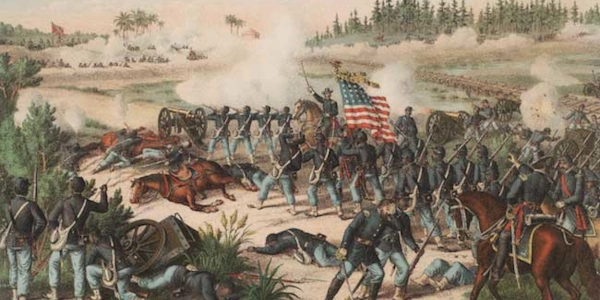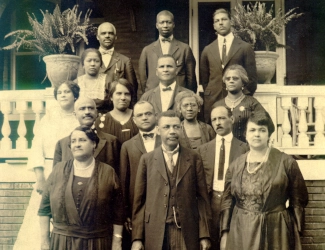
Image above: Picture outside Maggie Walker's Home of her (lower left) and other leaders in Jackson Ward, 1930's. Courtesy National Park Service.
Spotlight on Lesser Known History
Maggie L. Walker National Historic Site
Virginia
America's Best History Spotlight
On this page we're going to Spotlight the lesser known historic sites and attractions that dot the history landscape across the USA and are worth a visit if you're in their area. And while they may be lesser known, some are very unique, and will be that rare find. You'll be, at times, on the ground floor, or maybe even know something others don't. It'll be fun. Visit them.

Maggie Walker NHS, Virginia
Maggie Lena (Draper) Walker was less than two years old when the Civil War ended, but by the time she was twenty years old, she had grown into a woman of such strength, even in the south that was foiling reconstruction into Jim Crow policies and politics that tried to prevent the black population in Richmond from prospering, that she would have none of that. It would be a long battle, take the rest of her life, and still needs completion. However, during her days in Jackson Ward, Maggie Lena Walker would join organizations, the Independent Order of St. Luke's, rise to the top, and help build the black businesses in the ward so that the people there were not dependent on the white businesses who didn't respect them anyway. Yes, she would become the first woman president of a bank, ... it would be far from her only notable accomplishment.
Photo above: Photo today of Maggie Walker's home, part of Maggie L. Walker National Historic Site. Tours are given of the home. Courtesy America's Best History.
Sponsor this page for $100 per year. Your banner or text ad can fill the space above.
Click here to Sponsor the page and how to reserve your ad.
Info, What's There Now, History Nearby
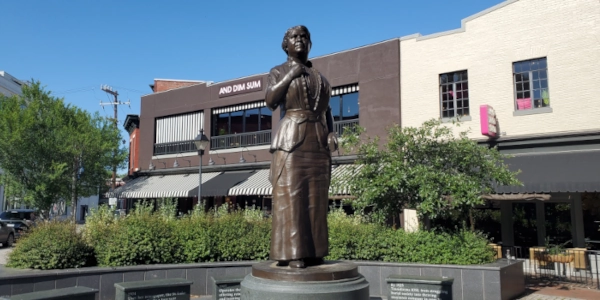
Maggie Walker NHS, Virginia
Today, a visit to Maggie L. Walker National Historic Site is a reminder of one side of the Jim Crow era that gets less credence than it should. And the story of Ms. Walker was far from the only black pioneer who navigated the era successfully. Yes, we hear of the literacy requirements for voting, the horrid emergence of the Klu Klux Klan, and the leftover leaders of the Confederacy taking back power in the states where they had formerly enslaved their black chattel, which occurred, in part, to the compromise in the Presidential Election of 1876 which gave the presidency to the Republicans in exchange for allowing Southern states to be headed by former Confederate soldiers. Yes, that happened, and it pushed back the Civil Rights of Black Americans for almost one hundred years.
And all Maggie L. Walker, Mary McLeod Bethune, Booker T. Washington, and W.E.B. de Bois would do (the other side of that story), was fight back and work to gain as much power as they could. And they were all colleagues of Maggie Walker, visiting her home for philosophic and practical plans to accomplish for their brethren what the politicians would not. Maggie Walker would turn Jackson Ward into a black owned business haven with good schools, Booker T. Washington would work on education projects leading to the formation of schools, such as the Tuskegee Institute, and W. E. B. Du Bois, with friends Mary White Ovington, Moorfield Storey, Ida B. Wells, Lillian Wald, and Henry Moskowitz would form the National Association for the Advancement of Colored People in 1909.
Image above: Photo of Maggie Walker's statue and plaza in Jackson Ward today with wayside and inscriptions describing her achievements as a black businesswoman who inspired the entire area to protest Jim Crow laws and compete, with black owned businesses, with the white businesses nearby. Courtesy America's Best History. Below: Variety of photos of Maggie Walker through the years, (left) 21-26 years old, Richmond Photo Co.; (center) Maggie in 1917; (right) Between 1910-1920, Wims Burg Photo Co. All photos courtesy National Park Service.
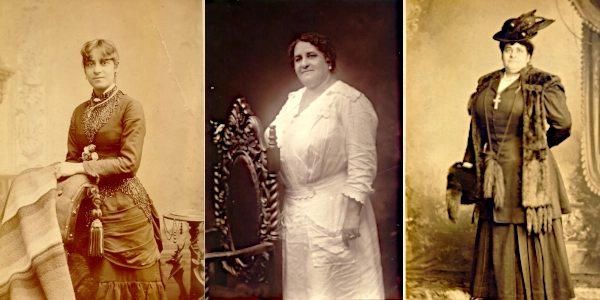
Where Is It
The Visitor Center for the Maggie Walker National Historic Site is located at 600 North 2nd Street, Richmond, VA 23219. There is free street parking along 2nd Street with a three hour limit. The home itself is located around the corner on E. Leigh Street. The entire Jackson Ward area surrounds her home; ask at the Visitor Center about taking a self-guided tour of Jackson Ward with a provided map and website descriptions. They are working on improving an app with voice descriptions of the sites you will see.
Minute Walk in History
Maggie Walker, born during the Civil War, but came to prominence as a Black History Pioneer when she put the region of Richmond known as Jackson Ward on her back, creating schools, insurance companies, banks, stores, to help the African American community rise up on their own volition, not accepting the crumbs of the white community right next door on Broad Street. Take a walk through her home and the neighborhood that she, and others, spawned into a thriving community. Who were her contemporaries, ... De Bois, Booker T. Washington, Bojangles Robinson. Music by Marianne Anderson; Oh, What a Morning and My Way Cloudy. Can't help but think that as the second song repeats "... send an angel down," that that angel was Maggie Walker.
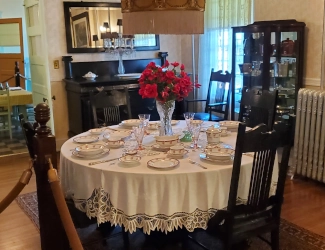
What is There Now
Maggie Walker NHS
There is a visitor center off the back courtyard of the house with an introductory film, exhibits, and ranger orientation. A tour of the Maggie Walker house is held on the hour from 10:00 a.m. to 3 p.m. Photo above is of the dining area. Courtesy America's Best History.
There are facilities on site and a water fill station. After the house tour, if you wish, you can go on a walking tour of Jackson Ward, where the statues of Maggie Walker and Bojangles Robinson sit, as well as the buildings associated with Maggie Walker and the Independent Order of St. Luke's. Some of the buildings are occupied, but others, like the initial insurance company, which you can see from the courtyard, are vacant.
When Open and How Much
Open Tuesday to Saturday 9:00 a.m. to 4:30 p.m., some holidays excluded. There is no fee.
Fees and hours are subject to change.
Websites
Maggie Walker National Historic Site
History Nearby
Since you are in downtown Richmond, you are near many Siege of Richmond sites from the Civil War in 1864 and 1865. Of course, there's a whole lot more than that as well as Richmond was one of the epicenters of frustration with the British Government during the years prior to, and during, the American Revolution.
Photos, History, and More Spotlights
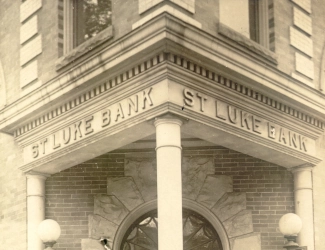
Accomplishments
At fourteen to seventeen years of age, Maggie L. Walker joined the Independent Order of St. Luke's, and began teaching in the local schools during the day and studying accounting at night. She protested the inequality of white and black student's graduation ceremonies; today they are held in the Hippodrome theater up the street from her home, and started a family. In 1895, she established a Juvenile Branch of St. Luke's, and four years later, she was elected the national chapter's Right Worthy Grand Secretary (Secretary-General), holding the post until 1934.
By 1901, the Independent Order of St. Luke's and Jackson Ward knew what they had in Maggie Walker, but she wanted more. "We need a savings bank, chartered, officered, and run by the men and women of this Order ... Let us have a bank that will take the nickels and turn them into dollars." Two years after that statement, the St. Luke Penny Saving's Bank opened; its founder and president was Maggie Lena Walker, the first female to charter a bank in the United States.
There were many other accmplishment; an insurance company, a newspaper, a retail store on Broad Street, on the edge of Jackson Ward, in a predominantly white neighborhood. That venture failed, because the white businesses around her forced her suppliers to withhold merchandise. One that did not, however, was her organization of a strike against segregation in the street-car system. The boycott caused the company to go bankrupt within two months.
Photo above: St. Luke Penny Saving's Bank, date unknown. Below: Headquarters of the Independent Order of St. Luke, date unknown. Both photos courtesy National Park Service.
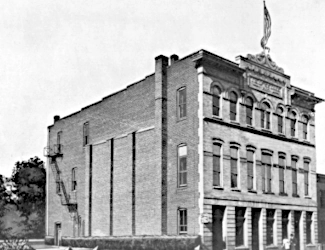
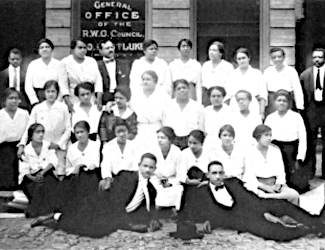
Independent Order of St. Luke's
The Independent Order of St. Luke's began in 1867, two years after the Civil War ended, founded by Mary Ann Prout in Baltimore. It was a benevolent organization, focusing on helping African Americans with finances during times of illness, old age, and burial. Two years after Walker joined, the organization split, and the Richmond chapter was run by William M. T. Forrester for thirty years. However, Forrester's tenure saw a downturn in their fortunes and membership, now down to one thousand. In two years, Walker doubled its membership; several years later it had grown to one hundred thousands. New headquarters were built, today across a field behind Walker's house. It is not used today, but intact.
The St. Luke Penny Saving's Bank changed its name after a merger to the Consolidated Bank and Trust and was the largest black owned bank in the USA until it was sold in 2005. It is now part of Premier Bank.
Image above: Office workers of the Independent Order of St. Luke's, date unknown. Below: Grand Officers of the Juvenile Department with Maggie L. Walker in center, date unknown. Both photos courtesy National Park Service.
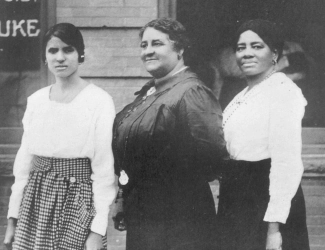
Buy Second Edition
America's Best History Timeline

Great book to keep middle school to college students up to date on their American history.
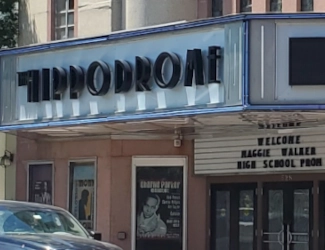
Jackson Ward
The original name of Jackson Ward was Central Ward, but after the Civil War ended in 1865, it slowly became the home of black men and women who had previously been slaves and those who already made their homes and businesses there. It became a political district through 1905. And through the reign of Maggie Walker, prospered with black owned business in the area around her home. It was called by nicknames, "The Harlem of the South," and "Black Wall Street of America." Why was it known as the Harlem of the South? Well, because its famed theatre, the Hippodrome, was home to concerts and visits by Duke Ellington, Ella Fitzgerald, Lena Horne, Cab Calloway, Billie Holiday, Nat King Cole, James Brown, and others, some listed below.
Today many of the buildings of Black Wall Street associated with Maggie Walker, and those that were not, were repurposed, or still stand in disarray if you take the walking tour. Two statues honor the past residents and performers; one of Bojangles Robinson, and an entire public square dedicated, with statue, to Maggie Lena Walker.
Photo above: Hippodrome Theater today, former host to many of the famous entertainers of the time; Bojangles Robinson, John Coltraine, Thelonius Monk, among many others. At time of photo, hosting the Maggie Walker High School Prom. Below: Wayside explaining the Jackson Ward history of Leigh Street. Both photos courtesy of America's Best History.
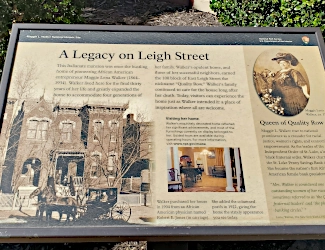

T-Shirts and Gifts from the official souvenirs of Americasbesthistory.com.
About
America's Best History where we take a look at the timeline of American History and the historic sites and national parks that hold that history within their lands.
Photos courtesy of the Library of Congress, National Archives, National Park Service, americasbesthistory.com and its licensors.
- Contact Us
- About
- © 2024 Americasbesthistory.com.
Template by w3layouts.

